In June 1994, Richard Garfield was the rising superstar of hobby gaming. A Ph.D. in combinatorial mathematics, Garfield had launched his wildly successful collectible card game, “Magic: The Gathering,” barely a year earlier, but it had already sold 170 million cards. From its “Alpha” release in August 1993, the game’s initial inventory of 295 individually named cards had swollen to 500, each featuring an original illustration on its face. Taken together, the cards painted a picture of a fantastical land filled with wizards, demons, sorcerers, and enchanted stones. Hobby-and-game shops routinely sold out of the meager inventories they received from Wizards of the Coast, the game’s publisher, which struggled to keep up with demand. And when my then-6-year-old son, Sam, was bitten by the Magic bug, I smelled a story.
“Seldom were artists told anything other than the card’s title and its effect.”
I pitched an article about Magic, which was just inducted into the National Toy Hall of Fame, to a magazine in New York. Somehow, I convinced this well-funded monthly to fly me and Sam from San Francisco to Seattle so I could interview Garfield. My plan was to get the game’s inventor to explain his creation to a general-interest readership, cherry-pick a few details to give my story color (“Garfield appears slightly dazed as he sits cross-legged and shoeless on an office chair, his feet warmed by a pair of rainbow-hued tabi socks … ”), and then write up the play-by-play of a game of Magic between my child and the gaming Goliath.
Sam’s fascination with Magic was precocious. Though the game had been aimed at college students, it had found an audience among kids in middle and high school, too. Sam was about to enter first grade. Therefore, by prior agreement with Garfield’s handlers, Sam would be allowed to bring his most powerful Magic deck to the table—as many cards as he liked, as long as they could be shuffled—while Garfield would be limited to a randomly selected, unopened “starter” deck of 60. That meant my son would have a distinct advantage over Garfield, as he could fill his personal deck with some of the game’s most fearsome creatures and fiendish enchantments, including ones found in Magic’s first two expansion sets, Arabian Nights and Antiquities.

Left to right: The Alpha, Beta, and Unlimited printings of Stasis. Images via Card Kingdom
Sam had built his deck by trading with kids in our neighborhood; sitting around our dining room table, Sam’s older friends took pains to explain these trades to my wife, Pat, and me, lest we accuse them of taking advantage of our son. Sam also sweet-talked his indulgent parents into buying him booster packs, as well as the occasional single card—sold at a steep markup and housed in a protective sleeve—from his favorite local gaming shop.
As it turned out, Sam’s advantage over Richard Garfield was entirely theoretical. Garfield cleaned my kid’s clock.
“We didn’t expect the game to hit such a broad market; I thought it was too complicated.”
Listening to an audio recording of their 1994 match recently, I was struck by how patient Garfield was with my chatterbox son, despite having flown in from Japan just a few hours earlier (hence his dazed countenance and, I guess, the tabi socks). As the game unfolded, Garfield filled my tape recorder with the origin stories of Magic’s unique vocabulary (“mana,” “damage,” and “tap” are among its terms of art), all the while steadily, relentlessly, backing Sam into the corner from which he would not escape. Throughout the half hour the two spent playing Magic, Garfield’s voice was calm and friendly, even as terrible damage was meted out on both sides by pitiless creatures and nasty spells. Sam seemed unfazed, peppering Garfield with questions and soaking up as much Magic wisdom as he could from the game’s affable inventor. Sportsmanship guided their discourse, and at the conclusion of their match, they each took their turn in the classic gamer call-and-response: “Good game,” my son said to Richard Garfield. “Good game,” Richard Garfield replied back.
Within a week, I had sent a draft to my editor, who naturally asked for a few revisions before declaring the article ready for publication. About a month or so after that, I received a check in the mail for my trouble.
The piece never ran. I’ll never know if my failure to get that plum writing credit halted what would have been a meteoric rise into the upper echelons of big-time magazine publishing, but Sam made out like a bandit: He ended up with the artwork for one of the original 295 cards in Magic’s Alpha series. Today, this colorful drawing on paperboard could probably bring Sam a quick 10 grand, but he’s not selling, so don’t even ask.
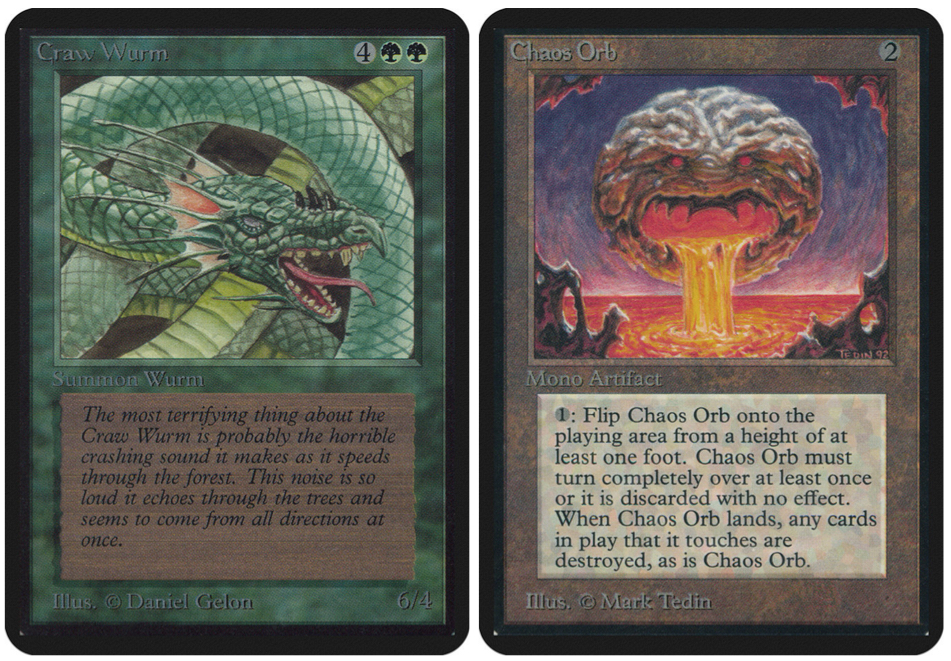
Left: Craw Wurm, by Daniel Gelon. Right: Chaos Orb, by Mark Tedin. Images via Scryfall
Sam’s prize would not find its way into his hands for another three years, but the catalyst was definitely that hour or so we spent with Richard Garfield in the noisy and hectic offices of Wizards of the Coast 25 years ago.
I had begun the interview with what I figured was an obvious, softball icebreaker: “Yes,” Garfield responded when asked if he was related to President James Garfield (1831-1881), “he was my great-great-grandfather.”
That historical tidbit out of the way, Garfield proceeded to explain the basics of Magic. “One of the underlying premises of the game,” he said, “is that there’s supposed to be a very simple set of rules and all the cards are exceptions. Every card allows you to break the rules at some point. That’s how I think of it.” While the practice of making certain cards exceptions to the rules has probably been around for as long as people have played cards—think “jokers wild”—Garfield pushed the practice to unprecedented proportions.
Exceptions aside, the basic rules are indeed very simple. “Each player chooses a set of 60 cards to play with,” Garfield said. “Each player starts with 20 life points, so the object of the game is to reduce the other player’s life points to zero. To begin a game, each player shuffles their deck and draws seven cards.”
“Eight,” Sam corrected. “The first player picks eight.”
“That’s right,” Garfield replied. “At the beginning of your turn, you draw an additional card, and if you have a land card in your hand, you can put one down. Each land generates energy, or mana, which is used to cast spells or attack with creatures. There’s a very simple coding on the cards that tells you what sort of energy you need to cast a particular spell. For example, this card, Phantasmal Terrain, has two blue mana symbols. So, it requires two blue mana, or land cards, to be played.”
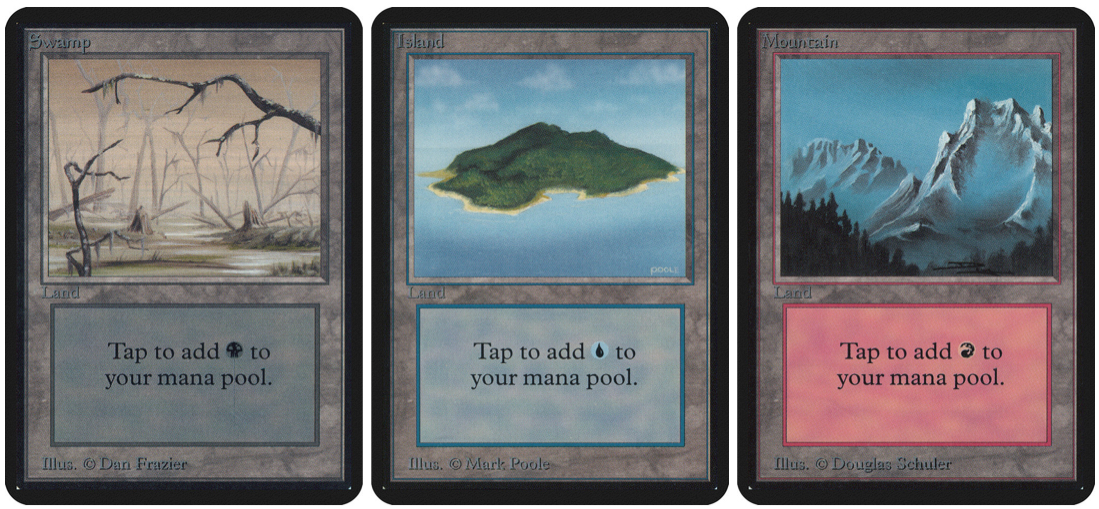
Left to right: Three lands by Dan Frazier, Mark Poole, and Douglas Schuler. Images via Scryfall
The land or mana cards (the terms are sometimes used interchangeably, if imprecisely) come in five different colors—white, blue, black, red, and green. White mana allows you to play virtuous cards such as Serra Angel, a flying creature with offensive and defensive ratings of four each, which makes Serra Angel a strong card but by no means the strongest in the game. Blue mana summons cards such as Clone, whose offensive and defensive ratings are zero. Clone makes up for this deficiency by letting you copy any creature in play owned by any player, and then Clone takes on that capability as a part of your deck. That’s pretty handy. Black mana, as you might suspect, lets loose a range of nasty creatures, with names like Plague Rats and Demonic Hordes. Red creatures include a number of orcs, goblins, and ogres, while green mana can be used to summon grizzly bears, giant spiders, wolves, and, not too surprisingly, elves.
Getting any of these cards into play is accomplished by tapping, or turning, the land cards that you’ve placed face up on the table. This gives your opponent a hint at what might be about to come their way, and even when you put a creature into play, they usually can’t be used to do damage until the next turn, unless the card is an instant, a category of card that’s yet another exception to the rules.

Left: Clone, by Julie Baroh. Right: Vesuvian Doppelganger, by Quinton Hoover. Images via Scryfall
In 1994, I’d been especially curious about the origins of the word “tap.” “We needed a word to indicate that the card was drawn,” Garfield had told me. “For a while, we were using cocked,” he said, “as in to cock your card, but that didn’t have very nice flavor to it. Tap seemed good because it suggested you were drawing power from the card, like, ‘I’m going to tap this mountain.’”
Got it, and when you turn the handle of a water faucet, which some people call a tap, you turn it to the side, I offered, trying to be helpful.
“Oh, true,” Garfield said. Maybe it was the jet lag, but Garfield had apparently not thought of that. “Oftentimes with words, meanings will just come up,” he said.
What Garfield had thought a lot about was the equity of his game, confirming a hunch I’d harbored about his intent. “When I first told people about the idea for the game,” he said, “frequently they would say, ‘Oh, that’s great. You can make all the rare cards powerful.’ But that’s poisonous, right? Because if the rare cards are the powerful ones, then it’s just a money game in which the rich kids win. So, in Magic, the rare cards are often the more interesting cards, but the most powerful cards are meant to be common so that everybody can have a chance. Certainly, if you can afford to buy lots of cards, you’re going to be able to build better decks. But we’ve tried to minimize that by making common cards powerful.”

Left: Demonic Hordes, by Jesper Myrfors. Right: Plague Rats, by Anson Maddocks. Images via Scryfall
At some point in our conversation, I asked Garfield about the dark and sinister imagery found on many Magic cards, and wondered if maybe this sort of stuff might be a bit too intense for 6-year-olds.
“We didn’t expect the game to hit such a broad market; I thought it was too complicated,” Garfield replied with a sigh. “I always design games for myself,” he added. “In this case, I expected the game to appeal to people who played games as a hobby. I didn’t expect it to extend too far beyond that.”
Magic was about to extend way, way beyond the hobby market, as Wizards of the Coast was gearing up for the game’s release in Toys “R” Us. (As of this writing, tens of billions of Magic cards have been sold, while the inventory of individual cards, each featuring a unique work of art, numbers more than 10,000.)
Garfield wouldn’t have predicted that his card game would be sharing shelf space with Barbies and Hot Wheels, which is why he probably didn’t expect to have to be answering questions about whether some of the imagery on his cards might be too intense for little kids. “As one of my friends put it, ‘Why do the Plague Rats have to have so many pustules?’ I like the dark flavor of Magic,” he said, “but a lot of times I would prefer to be dark like Hitchcock, where not everything is shown or so graphic. And I don’t want to offend people with the cult images. That sort of thing is not uncommon in the hobby market, but in the broader market, some of that stuff is not so acceptable.”

Left: Serra Angel. Right: Benalish Hero. Both by Douglas Schuler. Images via Scryfall
Garfield had also thought a lot about how women were depicted on Magic cards. “We’ve tried to make sure women aren’t always portrayed in skimpy clothes all the time,” he said. To that end, he’d succeeded with cards such as Serra Angel, whose bare-shoulder bodice is actually more modest than the one worn by the original Wonder Woman.
As we spoke, it became clear that Garfield felt a deep connection to the artwork on his cards. I did, too, which is the other reason, beyond my kid’s precociousness, that I’d wanted to speak with Richard Garfield about Magic.
I’d discovered my connection to Magic cards during one of those trading sessions around our dining room table. Amid all the images of horned creatures, walls of fire and ice, glaring skulls, and slashing swords, I’d noticed a card whose artwork looked familiar. It depicted a white clown balancing on a seesaw across from a kneeling jackal-like creature, whose eyes were bound with a white scarf and whose paws were obscured by a beach ball, or something like a beach ball; it really didn’t matter. The title of the card was “Stasis,” and when I looked at the card more closely to read the artist credit, there was the name of Fay Jones.
Pat and I had known Fay and her husband, Bob, who died in late 2018, when we lived in Seattle in the 1970s and ’80s, before we had kids. When I contacted Fay in 1994 about her Magic card, she revealed that she and Richard Garfield were related. That family connection was how her assignment to create the artwork for a Magic card had come about. It was also probably why Garfield had agreed to speak with me.
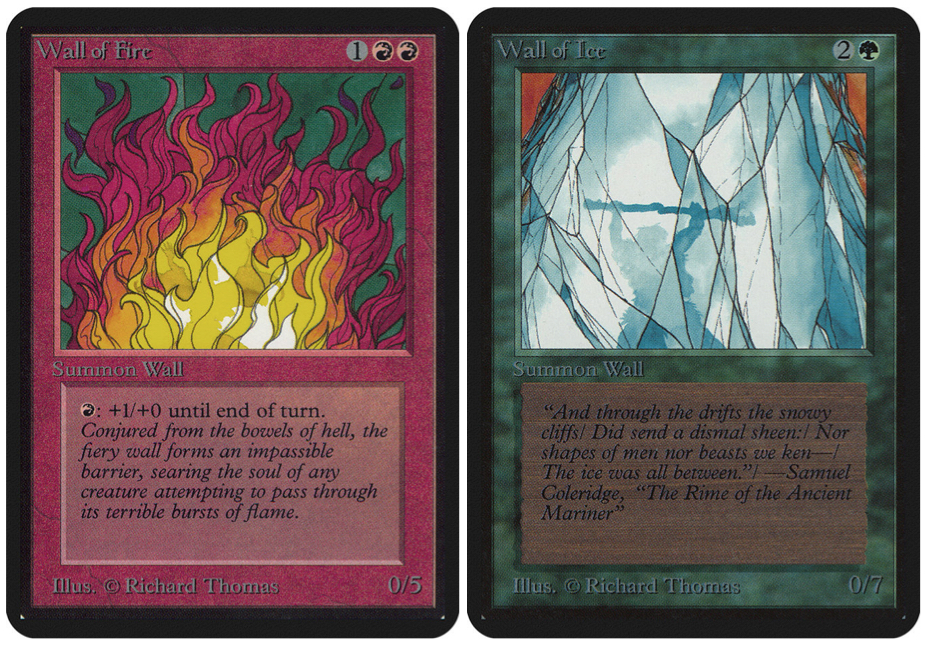
Left: Wall of Fire. Right: Wall of Ice. Both by Richard Thomas. Images via Scryfall
Recently, I spoke to both Richard Garfield and Fay Jones to fill in some of the gaps in this story. “His father’s mother and my mother were sisters,” Jones told me. “I think that makes us first cousins once removed. I’ve known Richie his entire life. He was always very sweet and kind.”
Fay used “Richie” to differentiate Richard Garfield, the Magic card guy, from his father, Richard Garfield, the architect. “My cousin Richard and I have always been close,” Fay continued. “We saw each other pretty regularly. They had a big house in Portland, and were always extremely hospitable. Lots of my Seattle friends ended up staying with them whenever they were doing art projects in Portland.”
Because of that closeness, in 1993, Richie invited Fay to create artwork for his forthcoming game. “The other artists that did cards were all straight-ahead fantasy artists,” Fay said, “but Richie asked me and Bob to each do one because we were his cousins. Bob couldn’t figure out how to design a card, but I was delighted to do it. Every year after that, I’d get a royalty check at Christmastime. I’d tease Bob with, ‘You see, If you designed a card, we’d have twice as much money!’”
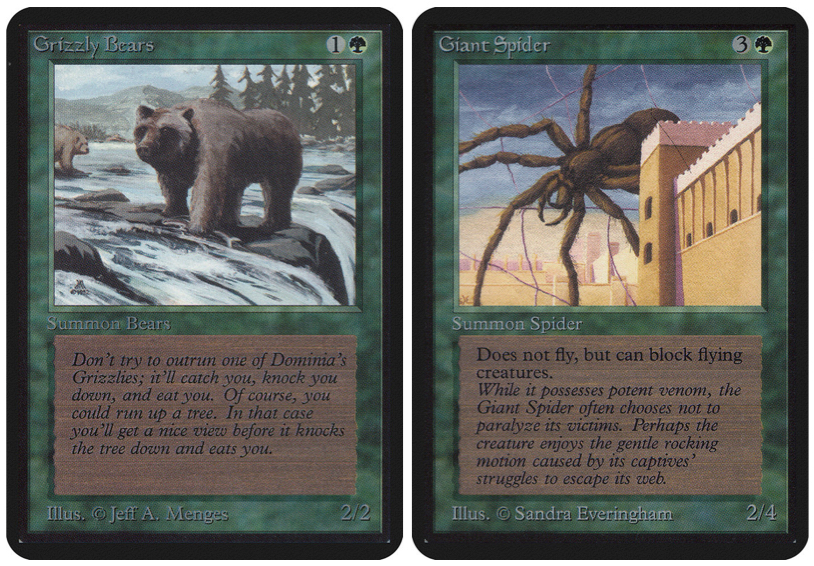
Left: Grizzly Bears, by Jeff A. Menges. Right: Giant Spider, by Sandra Everingham. Images via Scryfall
As for the imagery on the card, Richie was hands-off. “He probably told me the name of the card because there’s a seesaw in there,” Fay said. Curiously, Fay wrote the words “Stand Still” along the edges of the painting’s bottom-left corner, presumably to play with the concept of Stasis, but the words were cropped out of the final card.
“From the start,” Garfield had told me in 1994, “my intention with Magic was to have about half the card devoted to the art. I think make-believe is a very important component of games; the art really drives that. At the beginning, some people had this idea that all of the art should be done by one artist to give it a uniformity. But I was more interested in working with a lot of artists to represent a lot of different styles. I also wanted to make sure that the artist didn’t get dictated to very much, that they weren’t told what to do. I wanted them to put their own creativity into it. Seldom were artists told anything other than the card’s title and its effect. They’d figure out how it should be illustrated.”
A lot had happened in the intervening 25 years since that conversation, events that neither of us would have predicted in 1994, including that one day Garfield would be interviewed by Sam’s younger brother, Tom, who gets paid to play video games at IGN. When we spoke recently, we talked about the odd ways in which the Marks, Garfield, and Jones families have crossed paths over the years, and then Garfield did his best to remember the circumstances that led to Stasis.
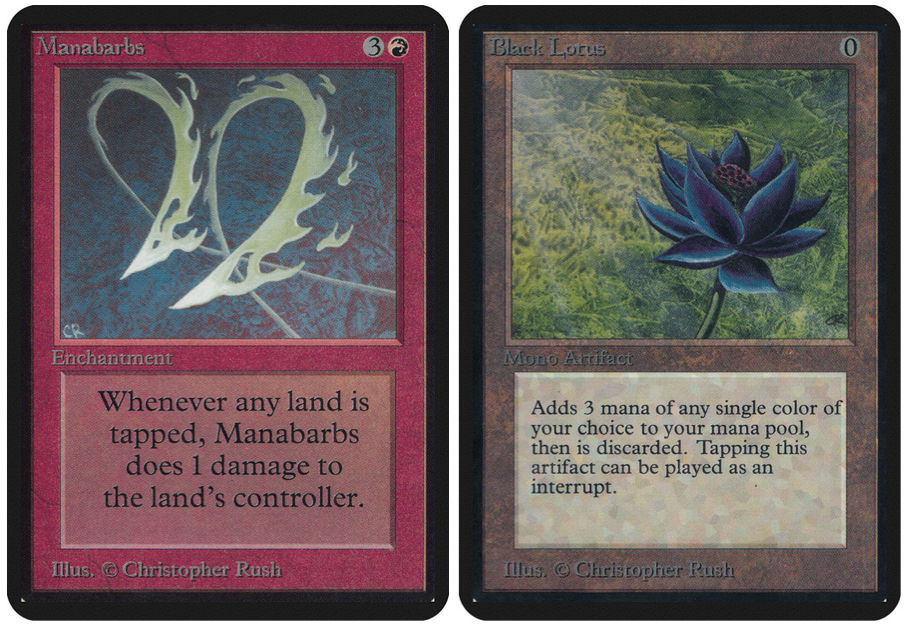
Left: Manabarbs. Right: Black Lotus. Both by Christopher Rush. Images via Scryfall
“I was drawn to art on cards intuitively,” Garfield told me, “but over time, it became clear that part of the function of the art was to help people identify the card at a glance. When you’re talking about 300 or so different cards, this connection between an image—the form—and the card’s function is really important.”
Prototyping was also important, as it gave Garfield and his colleagues a chance to test the game and perhaps tweak effects that weren’t causing the right impact for game play. “When Wizards of the Coast was printing the first test cards for Magic, they didn’t have art, so I told them to get any art they could, even if it was just random clip art. It was an opportunity to have some fun, so we used pictures of Calvin and Hobbes, images from maps for lands, and superheroes like the Hulk from random comic books lying around the office. We also played with visual puns. For example, the picture for a card that heals a character was somebody’s heel.” Garfield is a fan of the Belgian cartoonist Hergé, so he added the cartoonist’s work into the mix. “I liked his mountains in particular, so I used the mountains from Tin Tin for the mountain cards in Magic.”
After this prototyping phase, Wizards of the Coast took over responsibility for finding the artists who would create the final illustrations for the game’s first Alpha release. “I was only indirectly involved with that part,” Garfield told me recently. “Wizards hired Jesper Myrfors, a graduate of Cornish College of the Arts in Seattle, to be the head artist. He got a lot of his fellow students to create artwork for Magic cards. The only picture I got was Fay’s.”

Left: Goblin Balloon Brigade, by Andi Rusu. Right: Elvish Archers, by Anson Maddocks. Images via Scryfall
This was news to me, and it made me deeply uneasy. I had always worried if Garfield resented the fact that the original art his cousin had created for his landmark card game had disappeared into the ether, as if by some perverse enchantment cast during a game of Magic. But it never occurred to me that Stasis had been the one and only card whose art he’d personally commissioned. I took a deep breath and listened as he continued his story.
“I don’t remember, but I’m sure I gave her as little direction as possible,” Garfield said. “He gave me no guidance whatsoever,” Jones confirmed with a laugh. “I probably told her the name of the card and concept behind it,” Garfield continued, “but my philosophy, which I passed on to Jesper, was that artists are creative folk, and that the best way to take advantage of their creativity is to see where they go with the cards.”
Garfield was pleased with the results. “I loved the art at the beginning,” he said, “because of its variety. You had watercolors, the sorts of things that looked like they were from magazine graphics, and painterly pictures.” The problem, of course, is that Garfield and his colleagues at Wizards of the Coast were trying to create a cohesive world, which ultimately made his initial hands-off approach untenable. “There was no internal consistency,” he told me. “There was no unifying look, beyond the cards’ borders. But inside the borders, you had goblins that looked like they were from a dozen different species. And so, within a few years, more restrictive art guidelines were imposed, but in the early days, it was just ‘do what your inner muse tells you.’”
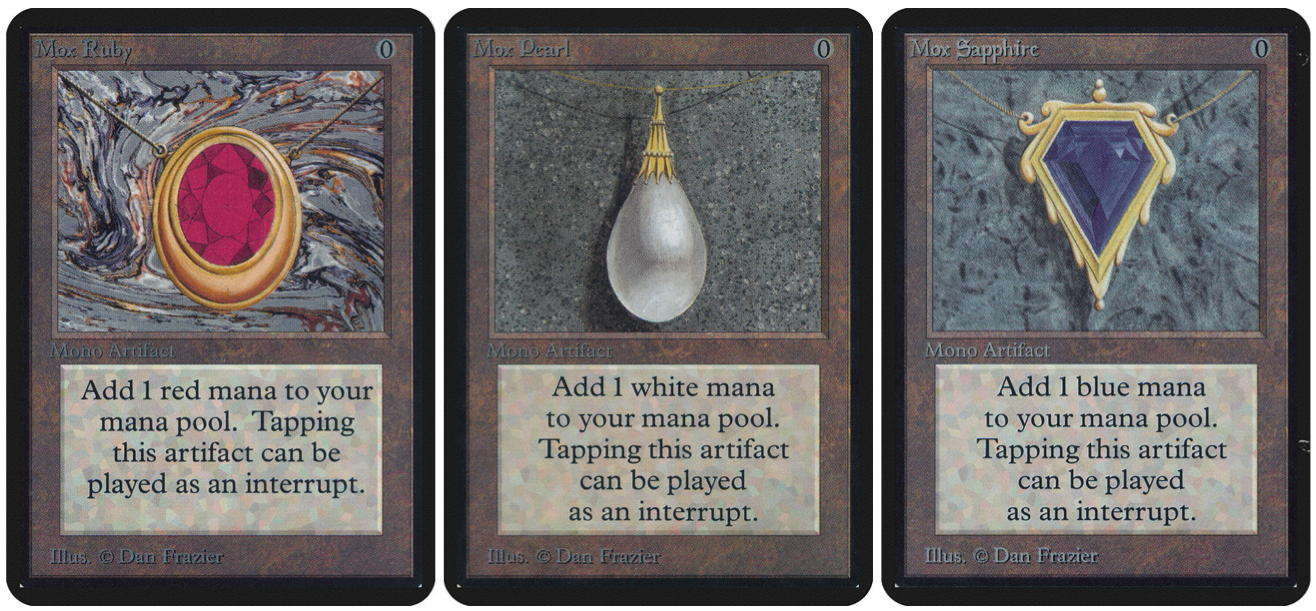
Left to right: Mox Ruby, Mox Pearl, and Mox Sapphire. All by Dan Frazier. Images via Scryfall
As an abstract painter, Bob Jones apparently found this lack of direction, as well as the constraints of a card, an impossible puzzle, but as a figurative painter, whose art often placed characters in magical landscapes, Fay Jones felt right at home. “Stasis was a really good picture for Fay,” Garfield said. “It’s not like I’d asked her to draw a thunder ax, where I’d expect a picture of an ax and the depiction of thunder. There’s a lot of room for creativity in a card with a more abstract name. I don’t remember if it was intentional or not, but the picture she illustrated was very good for her style because she does these dream-like paintings. Stasis seemed like a good match.”
“Sam’s fascination with Magic was precocious.”
After the game was released, in addition the welcome appearance of royalty checks she hadn’t anticipated, Wizards of the Coast regularly sent Jones batches of cards, which brings us back to 1994. The evening after I had concluded my interview with Richie, Fay and Bob joined us in the home of some mutual friends, who were kind enough to give me and Sam their spare bedroom for the night. (The well-funded magazine in New York’s travel budget was not well-funded enough for a hotel room.) Knowing Sam would be there, Fay had brought an unopened box of booster packs from the game’s second expansion series, Antiquities. The box contained 60 sealed packs, each of which contained 8 cards. Fay handed the box to Sam and then watched, her eyes wide with wonder, as he proceeded to open every last one of those booster packs, carefully sliding as many cards as he could into a few empty plastic sleeves before unceremoniously stuffing the rest into his backpack.
Right now, Magic card collectors around the world are letting out a collective groan at the thought of all those cards, some of which sell for thousands of dollars today, being stuffed into a 6-year-old’s backpack.
“Oh, that was perfect,” Fay said when we spoke about that moment recently. “Just perfect.”
Some time after that evening, no one can recall when, Sam decided to send Fay a thank-you gift. “He made me a necklace,” she told me. “Apparently the colors of the beads have significance in the game of Magic, but I don’t even know. He packed it in a proper white box with stuffing inside. That was very sweet, because he was pretty young, right?” For the record, the colors of the beads were meant to mirror those of the lands in Magic, and it’s a very good bet that Pat helped her son with the necklace.

The note that accompanied the necklace.
And then, in 1997, Fay sent Sam the original artwork for Stasis, although the circumstances associated with the passage of time between the interview with Richie and the arrival of Fay’s gift have been lost to fading memories. “Fay is a very sweet person, and that’s the way she lives her life,” Garfield said when I asked him recently how he felt about her gift to Sam. “I think it’s terrific.” As for Fay, over the years she’s been contacted by numerous Magic collectors looking for the Stasis artwork. Has she ever regretted giving her Magic treasure away? “It’s made things easier,” she told me. “When they ask, I just say, sorry, I gave it to a friend.”
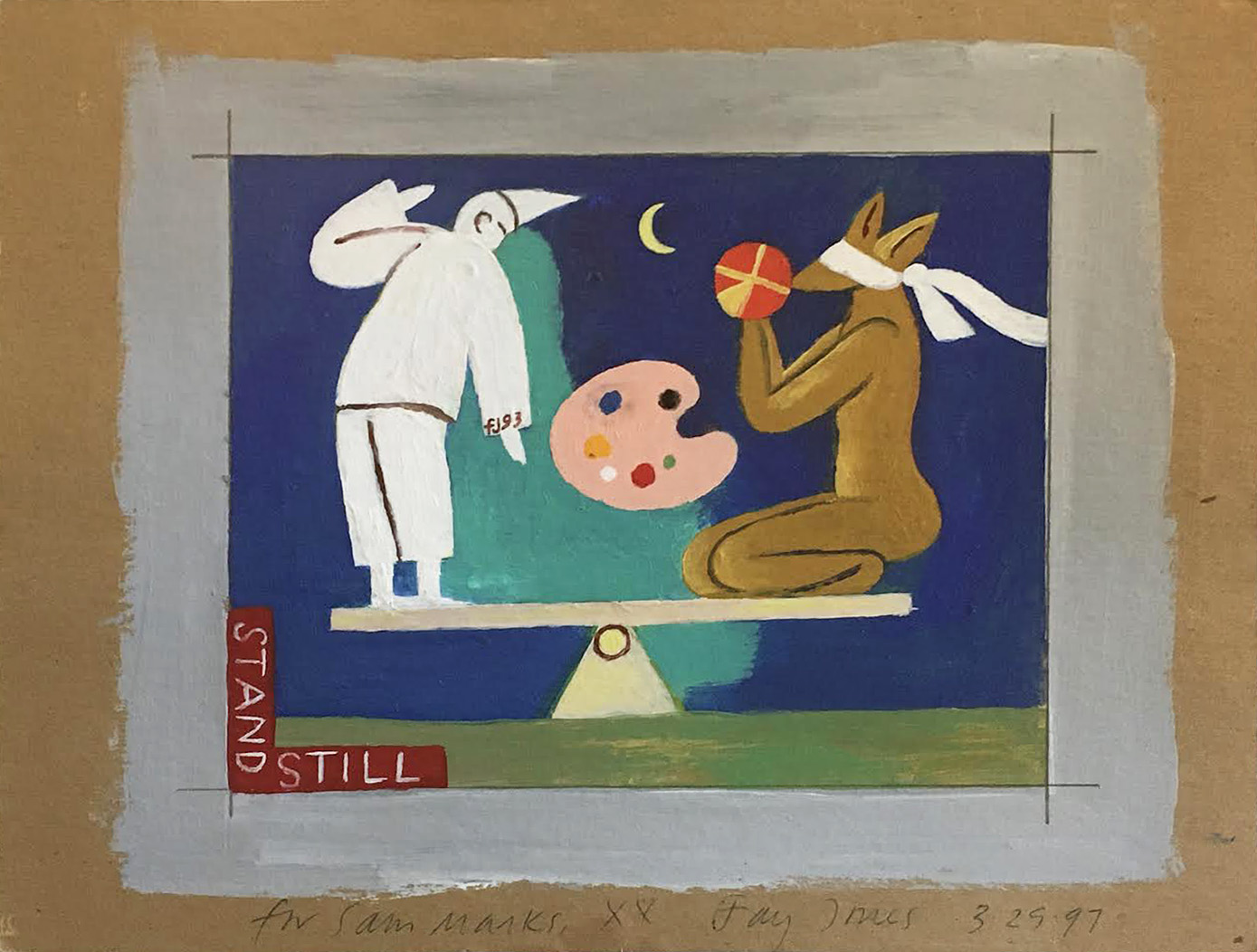

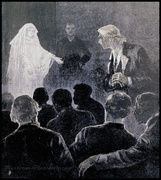
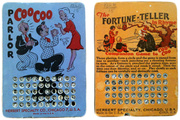 Reformed Gambling Swindle Becomes a Punch Board of Love
Reformed Gambling Swindle Becomes a Punch Board of Love
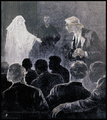 Ghosts in the Machines: The Devices and Daring Mediums That Spoke for the Dead
Ghosts in the Machines: The Devices and Daring Mediums That Spoke for the Dead Reformed Gambling Swindle Becomes a Punch Board of Love
Reformed Gambling Swindle Becomes a Punch Board of Love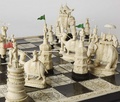 The Art of War: Exquisite Chess Sets Once Captured the Game's Global Heritage
The Art of War: Exquisite Chess Sets Once Captured the Game's Global Heritage Magic the GatheringMagic: The Gathering (aka MTG or just Magic) is a multiplayer, collectible …
Magic the GatheringMagic: The Gathering (aka MTG or just Magic) is a multiplayer, collectible … Mari Tepper: Laying it on the Line
Mari Tepper: Laying it on the Line Nice Ice: Valerie Hammond on the Genteel Charm of Vintage Canadian Costume Jewelry
Nice Ice: Valerie Hammond on the Genteel Charm of Vintage Canadian Costume Jewelry How Jim Heimann Got Crazy for California Architecture
How Jim Heimann Got Crazy for California Architecture Modernist Man: Jock Peters May Be the Most Influential Architect You've Never Heard Of
Modernist Man: Jock Peters May Be the Most Influential Architect You've Never Heard Of Meet Cute: Were Kokeshi Dolls the Models for Hello Kitty, Pokemon, and Be@rbrick?
Meet Cute: Were Kokeshi Dolls the Models for Hello Kitty, Pokemon, and Be@rbrick? When the King of Comedy Posters Set His Surreal Sights on the World of Rock 'n' Roll
When the King of Comedy Posters Set His Surreal Sights on the World of Rock 'n' Roll How One Artist Makes New Art From Old Coloring Books and Found Photos
How One Artist Makes New Art From Old Coloring Books and Found Photos Say Cheese! How Bad Photography Has Changed Our Definition of Good Pictures
Say Cheese! How Bad Photography Has Changed Our Definition of Good Pictures Middle Earthenware: One Family's Quest to Reclaim Its Place in British Pottery History
Middle Earthenware: One Family's Quest to Reclaim Its Place in British Pottery History Fancy Fowl: How an Evil Sea Captain and a Beloved Queen Made the World Crave KFC
Fancy Fowl: How an Evil Sea Captain and a Beloved Queen Made the World Crave KFC
Thanks for sharing, great story!
Quick note, you are off by a bit on the value of that art. Alpha art from bad commons doesn’t go for less than fifty grand, and for something as iconic as Stasis I would be shocked if it sold for less than $100,000 at auction, probably much higher.
Wonderful story.
I laughed and smiled the whole time while reading.
Stasis is the card that always to my mind when I think of how conventional the art has become since the early sets. The notion of Magic representing some coherent universe never appealed to me and it was precisely the kind of abstract and hazy images which made it accessible. The variety of styles spoke of barely lucid dreams, slipping in and out of consciousness, from the fantastic to the mundane to the absurd.
“I convinced this well-funded monthly to fly Sam and I …”!!! Are there no more copy editors? I’m seeing this egregious grammatical error in more and more published pieces.
It’s Sam and ME, of course. Oy!
Tx. That’s probably why my piece never ran. Fixed. -Ben
I was one of those kids getting free booster packs. My mom was an early investor…A friend of a friend and bought some shares… This got us free product. I remember putting together a complete set of Arabian Nights and selling it online–pre-Ebay–for…a cruise to the Bahamas. The cruise was a Magic convention of some kind, and many artists and Richard were there. Many artists gave me doodles or would sign their cards, some modifying the wording or powers of the cards. I have no collection left, but I kept those customized cards from the artists! Thanks for helping me re-live those days.
Nels, I agree completely. I started playing around Tempest. Everything felt so vast and unknowable.
my oldest grandson starting playing? magic at the age of 5 and is still playing while a
junior at Kenyon College. Kudos to his dad for nurturing him with games.
thank you for the article. brings back memories.
I’ve got good memories of playing Magic: The Gathering when I was a kid, despite an overly-zealous mom who believed the media reports that the game had links to the occult or Satanism. (Parents: If your kids are playing a damn card game with friends, be grateful they’re doing something that expends mental energy and doesn’t involve drugs or alcohol. Encourage them, don’t freak out about sensational media reports.)
The problem with Magic was its expense and arcane rules. It costs a lot of money to constantly keep up with new expansions, new chase cards and so on. Kids like me could easily be priced out of the game by other kids whose parents gifted them with virtually unlimited resources.
And that’s when my friends and I gave up Magic and started playing basketball…
Ah, yes…. this card game. Also known as ‘Crack the Gathering’ in certain circles.
Need the cards… Need. NEED More Cards! heh
I and my wife to be were into this many moons ago. We played friends and strangers at our local comic book store for hours on weekends. For the most part, I got my rear handed to me on platter. By just about everyone. I raged quit and gave all my cards to my wife.
Perhaps I better check up on some of the prices of those cards… as they were the early sets from when the madness started.
I have to say, I’m not sure the newer Online version has the same feel as the original.
Collecting virtual items does not have that Hands On feel of holding your favorite card and it’s wonderful artwork.
I’ve only a reproduction of my favorite card artist, Ruth Thompson, but it has it’s place of honor on a wall in my home.
This story was a delight to read. I was actually planning to get Stasis for a Stax deck soon (it basically locks out your opponents from doing anything), and to know the story behind the art is amazing!
Stasis is in my opinion the most sophisticated art work in old school magic. I love the card and the mechanics around it!
I recently got into MTG about 2 years back, and it seems that there is always something new to learn so the Spark of curiosity never dies. I stumbled on your article by first seeing some very strange and unique art on a blue card on Ebay. What started as a search for a better imagine of the art turned into me finishing a captivating read. To learn that the author had personal tries with the artist, that a 6 year old got to fly to play a round with the creator of his favorite game, and that “Richie” Garfield is as human as the rest of us has really made my day! It’s just shocking how deep a game can be, even when you’re not focusing on the game itself.
I started playing Magic when i asked a guy that was playing in the smoking room of a college what he was playing. He was very excited to teach someone new how to play. I was 25 then and 4th Edition was just coming out. I purchased some cards and began playing any chance i got. I like to describe Magic to people as being like playing chess but getting to pick your own pieces. That guy who taught me how to play is still one of my closest friends. I’m now 50 and still love to play. I will be teaching my son how to play and I hope he enjoys it as much as I have as I will probably leave all my cards to him when I’m gone. Great article and yes, if your kids play, let them use their mind. Magic is a great game of strategy, mechanics, and problem solving. I wish I could play more. Hopefully, my son will like it and we can play often.
This is an awesome story, Ben! I would like to ask if is there any chance of obtaining a print of Stasis?
I really enjoyed the story.
It painted a map in my own story.
Giving me detection on what I have.
In my position.
Ho and we’re it came from,
I only talked with miss Jones once briefly.
I will always have the energy she shared.
I would like to know more about
How to manage peace of her art.